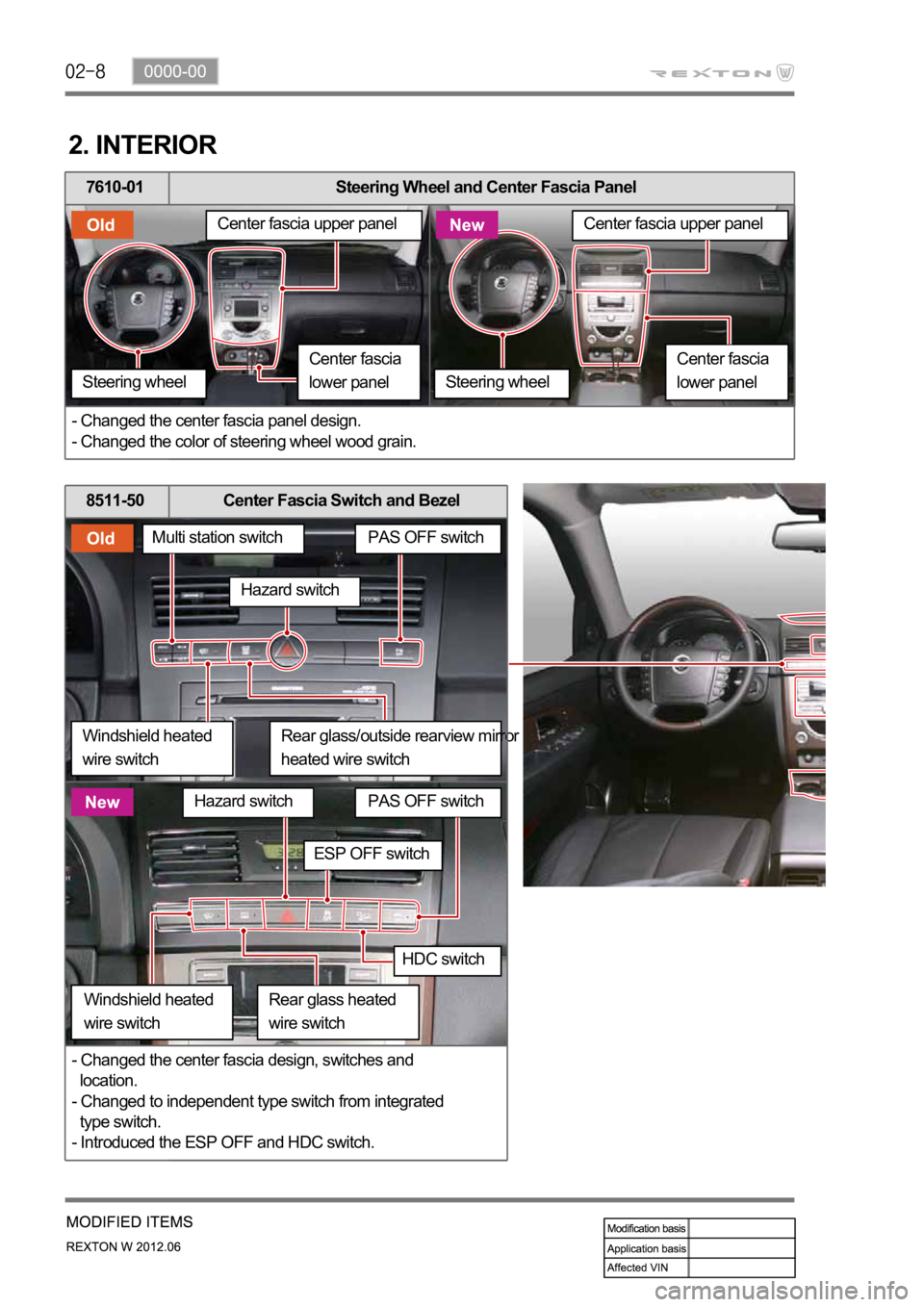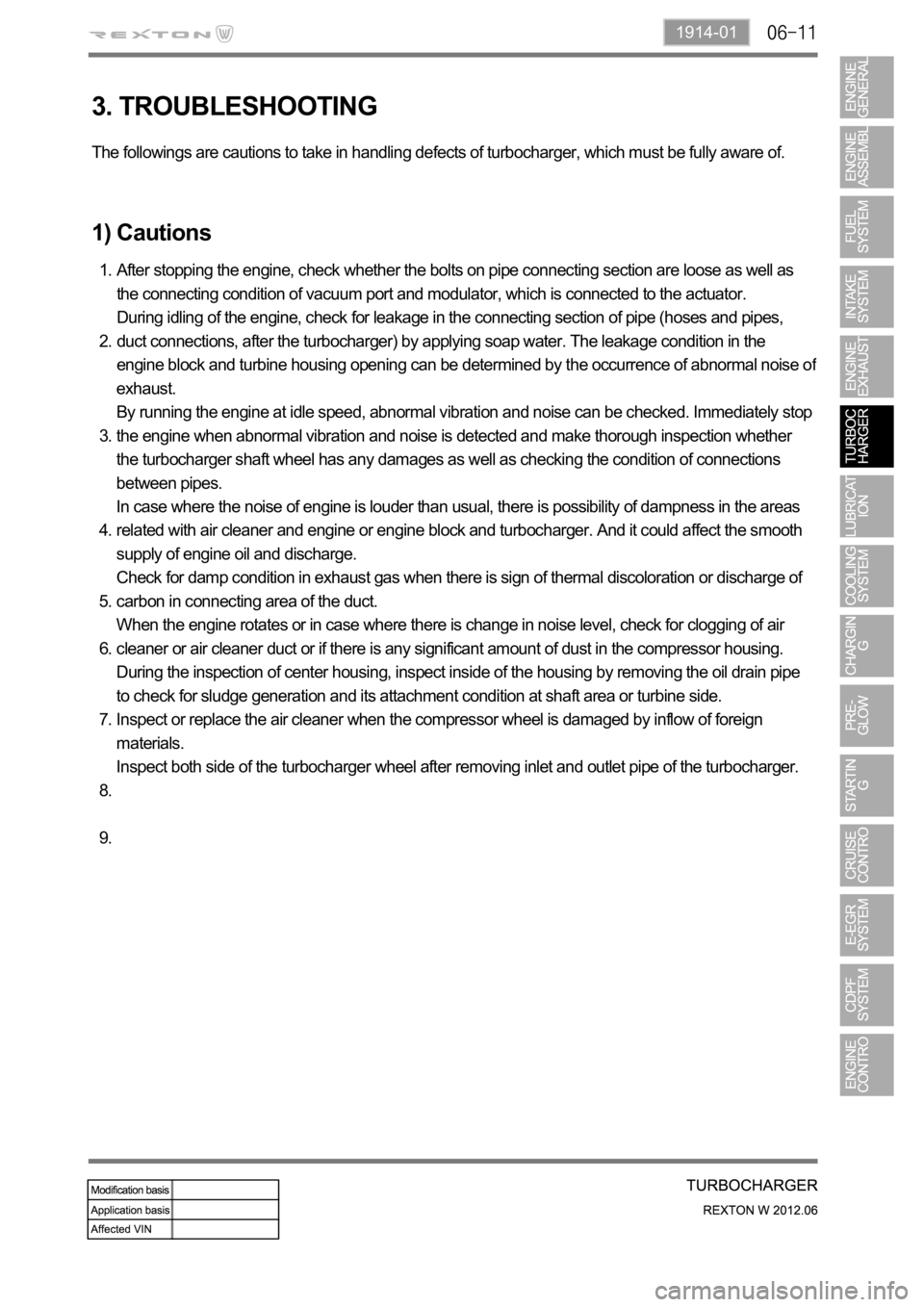change wheel SSANGYONG NEW REXTON 2012 Service Manual
[x] Cancel search | Manufacturer: SSANGYONG, Model Year: 2012, Model line: NEW REXTON, Model: SSANGYONG NEW REXTON 2012Pages: 600, PDF Size: 73.29 MB
Page 171 of 600

5720-03 Fender Panel &
Side Repeater Lamp
- Changed the fender panel design
according to the changes of head lamp
and front bumper.
- Moved the side repeater lamp to the
outside rearview mirror.
7930-11 Door Garnish
- Deleted the front and rear door garnishes.
7931-20 Side Lower Step
- Changed the side lower step design.
Side repeater lamp
Side
7110-10 Door Outside Handle
- Changed the door outside handle design.
7931-06 Front Wheel Arch Garnish
- Changed the front wheel arch garnish
design.
Page 172 of 600

0000-00
7931-09 Rear Wheel Arch Garnish
- Changed the rear wheel arch garnish
design.
4170-34 Wheel
- Added the wheel types (sputtering type &
diamond cut type). Standard wheel: Alloy
wheel
- Unify the wheel & tire specification
(255/60R18)
7931-01 Side Sill Garnish
- Changed the garnish design (from
independent type to integrated type).Diamond cut typeSputtering type
5210-18 Side Outer Rear Panel
- Changed the side outer rear panel design
according to the changes of rear combination
lamp.
Page 175 of 600

2. INTERIOR
Center fascia upper panel
Center fascia
lower panel
Steering wheel
Center fascia upper panel
Center fascia
lower panel
Steering wheel
7610-01 Steering Wheel and Center Fascia Panel
- Changed the center fascia panel design.
- Changed the color of steering wheel wood grain.
Multi station switch
Hazard switch
Windshield heated
wire switchRear glass/outside rearview mirror
heated wire switch
PAS OFF switch PAS OFF switch
Hazard switch
HDC switch
ESP OFF switch
Windshield heated
wire switchRear glass heated
wire switch
8511-50 Center Fascia Switch and Bezel
- Changed the center fascia design, switches and
location.
- Changed to independent type switch from integrated
type switch.
- Introduced the ESP OFF and HDC switch.
Page 181 of 600

4. ENGINE AND CHASSIS
4190-06 Wheel Module
- Added the wheel module in each
wheel according to introduction of
TPMS.
1491-01 Engine Control Unit
- Changed the logic according to
introduction of TPMS.
4190-13 TPMS Unit
- Installed TPMS unit with antenna
according to introduction of TPMS.
Page 304 of 600

0000-00
Torque change curve of engine and drive shaft
Compression stroke Combustion stroke
Small changes from engine (k):
Damper increases the torque changes to clutchLarge changes from engine (j):
Damper decreases the torque changes to
transaxle by absorbing the impact
3) Operation
Compensating the irregular operation of engine: The secondary flywheel operates almost evenly so
does not cause gear noises
The mass of the primary flywheel is less than conventional flywheel so the engine irregularity
increases more (less pulsation absorbing effect).
Transaxle protection function: Reduces the torsional vibration to powertrain (transaxle) by reducing
the irregularity of engine. -
-
-
Page 305 of 600

4) Features
Reduced vibration noise from the powertrain by blocking the torsional vibrations
Enhanced vehicle silence and riding comforts: reduced engine torque fluctuation
Reduced shifting shocks
Smooth acceleration and deceleration -
-
-
-
5) Advantages
Improved torque response by using 3-stage type spring: Strengthens the torque response in all
ranges (low, medium, and high speed) by applying respective spring constant at each range.
Stable revolution of the primary and secondary wheel by using planetary gear: Works as auxiliary
damper against spring changes
Less heat generation due to no direct friction against spring surface: Plastic material is covered on
the spring outer surface
Increased durability by using plastic bushing (extends the lifetime of grease) -
-
-
-
6) Drive Plate
Drive plate receives the power from the start motor when starting the engine. With this, the drive plate
initially drives the power train system. And, it is connected to the torque converter to transfer the engine
torque to the power train system.
Trigger ring
Drive plate
Components
Page 362 of 600

1914-01
3. TROUBLESHOOTING
The followings are cautions to take in handling defects of turbocharger, which must be fully aware of.
1) Cautions
After stopping the engine, check whether the bolts on pipe connecting section are loose as well as
the connecting condition of vacuum port and modulator, which is connected to the actuator.
During idling of the engine, check for leakage in the connecting section of pipe (hoses and pipes,
duct connections, after the turbocharger) by applying soap water. The leakage condition in the
engine block and turbine housing opening can be determined by the occurrence of abnormal noise o
f
exhaust.
By running the engine at idle speed, abnormal vibration and noise can be checked. Immediately stop
the engine when abnormal vibration and noise is detected and make thorough inspection whether
the turbocharger shaft wheel has any damages as well as checking the condition of connections
between pipes.
In case where the noise of engine is louder than usual, there is possibility of dampness in the areas
related with air cleaner and engine or engine block and turbocharger. And it could affect the smooth
supply of engine oil and discharge.
Check for damp condition in exhaust gas when there is sign of thermal discoloration or discharge of
carbon in connecting area of the duct.
When the engine rotates or in case where there is change in noise level, check for clogging of air
cleaner or air cleaner duct or if there is any significant amount of dust in the compressor housing.
During the inspection of center housing, inspect inside of the housing by removing the oil drain pipe
to check for sludge generation and its attachment condition at shaft area or turbine side.
Inspect or replace the air cleaner when the compressor wheel is damaged by inflow of foreign
materials.
Inspect both side of the turbocharger wheel after removing inlet and outlet pipe of the turbocharger. 1.
2.
3.
4.
5.
6.
7.
8.
9.
Page 454 of 600

A fourth correction is made according to the pressure error.
This correction is used to reduce the injection timing advance when the pressure in the rail is higher
than the pressure demand.
A fifth correction is made according to the rate of EGR.
This correction is used to correct the injection timing advance as a function of the rate of exhaust gas
recirculation. -
-
<003a004b0048005100030057004b004800030028002a0035000300550044005700480003004c00510046005500480044005600480056000f00030057004b00480003004c0051004d004800460057004c0052005100030057004c0050004c0051004a000300
44004700590044005100460048000300500058005600570003[in fact be increased in order to
compensate for the fall in termperature in the cylinder.
A. Main Flow Control
The main flow represents the amount of fuel injected into the cylinder during the main injection. The pilot
flow represents the amount of fuel injected during the pilot injection.
The total fuel injected during 1 cycle (main flow + pilot flow) is determined in the following manner.
When the driver depress the pedal, it is his demand which is taken into account by the system in order
to determine the fuel injected.
When the driver release the pedal, the idle speed controller takes over to determine the minimum fuel
which must be injected into the cylinder to prevent the enigne from stalling. -
-
It is therefore the greater of these 2 values which is retained by the system. This value is then compared
with the lower flow limit determined by the ESP system.
As soon as the injected fuel becomes lower than the flow limit determined by the ESP system, the
antagonistic torque (engine brake) transmitted to the drive wheels exceeds the adherence capacity of
the vehicle and there is therefore a risk of the drive wheels locking.
The system thus chooses the greater of these 2 values (main flow & pilot flow) in order to prevent any
loss of control of the vehicle during a sharp deceleration.
As soon as the injected fuel becomes higher than the fuel limit determined by the ASR trajectory control
system, the engine torque transmitted to the wheels exceeds the adhesion capacity of the vehicle and
there is a risk of the drive wheels skidding. The system therefore chooses the smaller of the two values
in order to avoid any loss of control of the vehicle during accelerations.
The anti-oscillation strategy makes it possible to compensate for fluctuations in engine speed during
transient conditions. This strategy leads to a fuel correction which is added to the total fuel of each
cylinder.
A switch makes it possible to change over from the supercharge fuel to the total fuel according to the
state of the engine.
Until the stating phase has finished, the system uses the supercharged fuel.
Once the engine changes to normal operation, the system uses the total fuel. -
-
(5) Fuel Control
The main fuel is obtained by subtracting the pilot injection fuel from the total fuel.
A mapping determines the minimum fuel which can control an injector as a function of the rail pressure.
As soon as the main fuel falls below this value, the fuel demand changes to 0 because in any case the
injector is not capable of injecting the quantity demand.